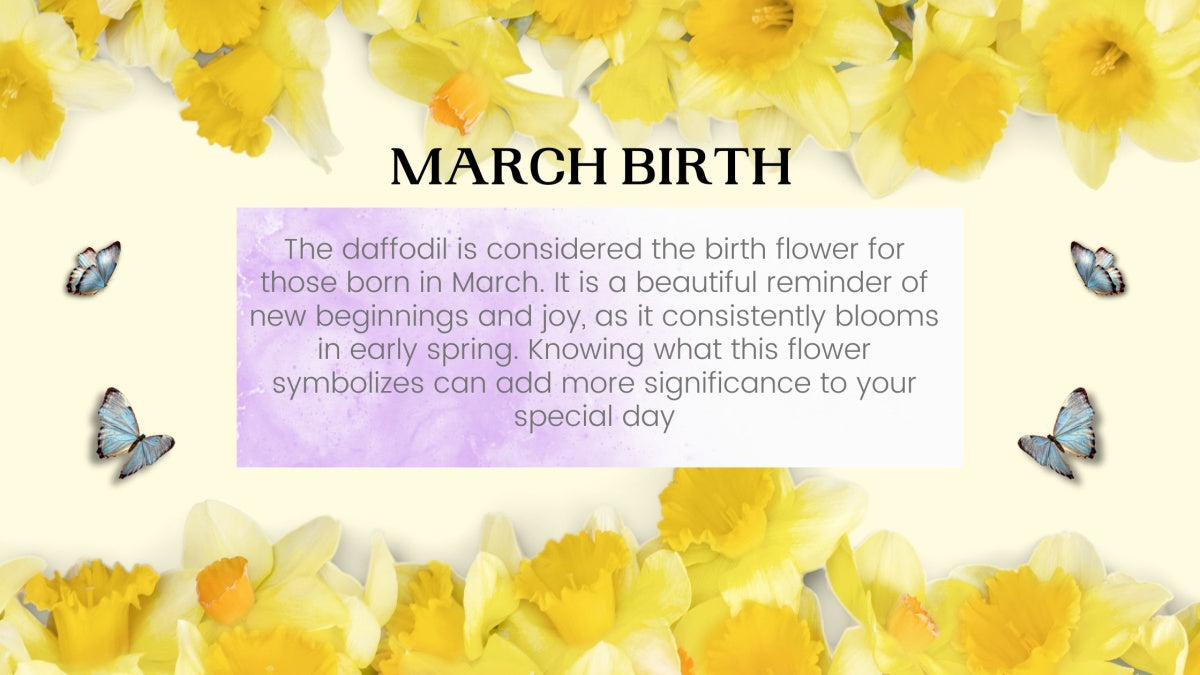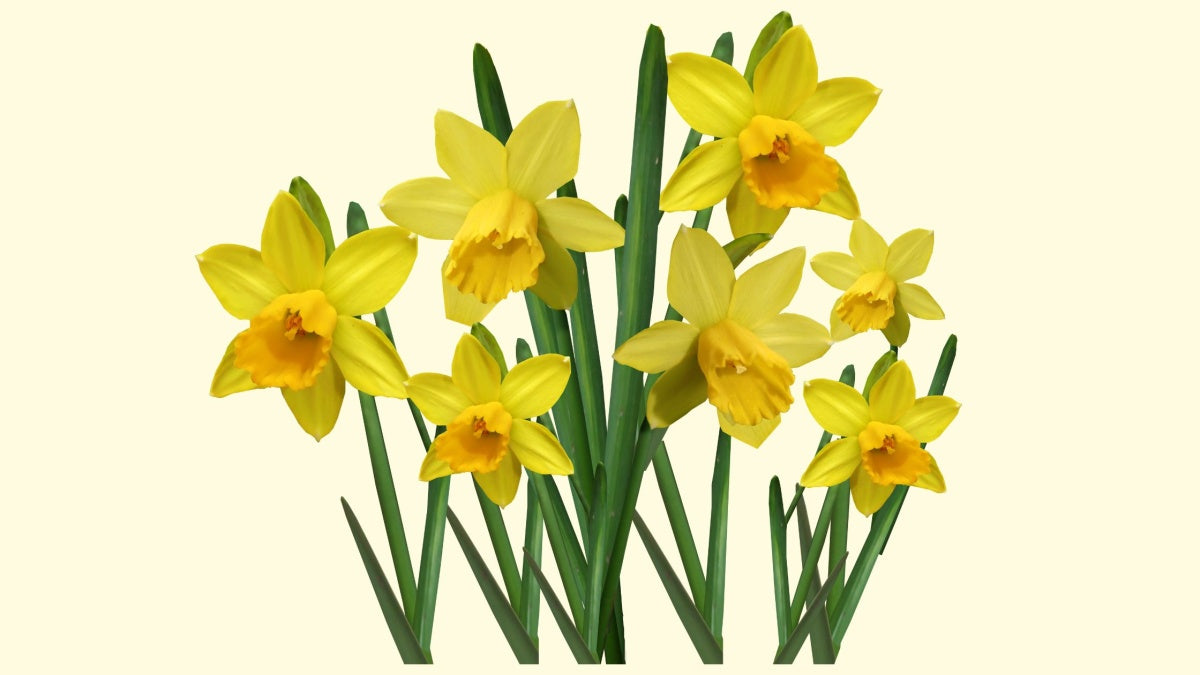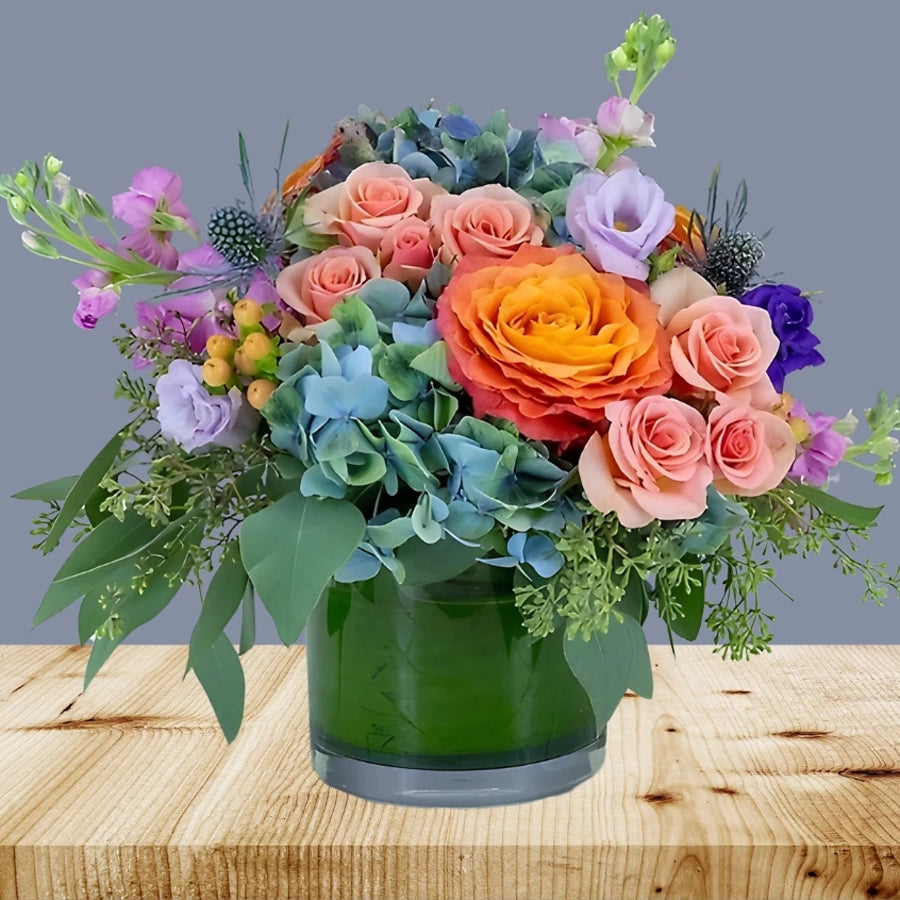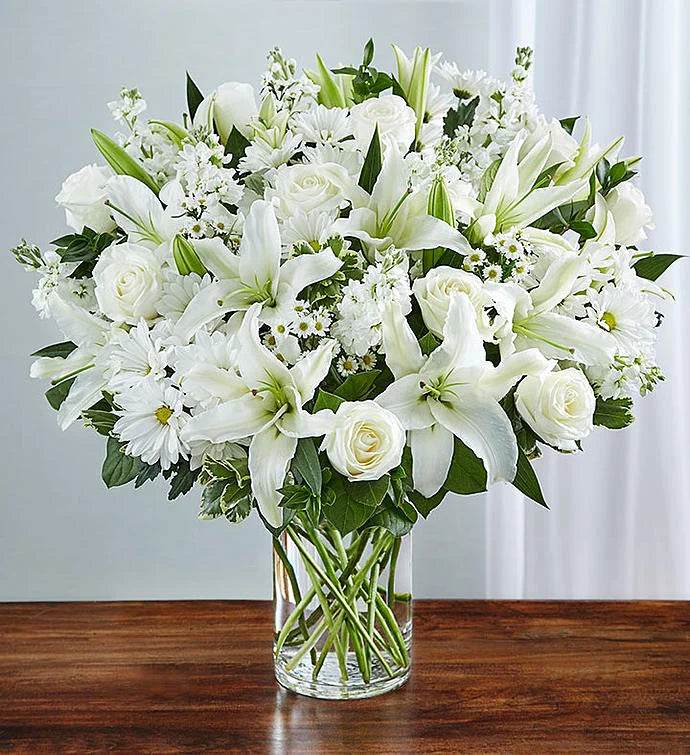March Birth Flower: Meaning and Symbolism of the Daffodil and Jonquil
The daffodil is considered the birth flower for those born in March. It is a beautiful reminder of new beginnings and joy, as it consistently blooms in early spring. Knowing what this flower symbolizes can add more significance to your special day. Let’s examine why the daffodil is considered the birth flower for March.

What is a Daffodil?
A daffodil is a flowering plant belonging to the Narcissus flower genus. These plants are part of a large family called Amaryllidaceae, which includes snowdrops, jonquils, and several other types of flowers. They bloom in clusters or single stems and have bright yellow petals, with smaller petals forming what looks like a cup in the center of each one.

The Symbolism Behind Daffodils
These March Birthday Flowers carry many symbolic meanings, making them perfect for celebrating those born in March. First, they represent new life and beginnings due to their early bloom period. Second, they also stand for joy and happiness a great way to start any new year!
Third, they are often seen as symbols of carefree days spent basking in the sunshine during springtime. Finally, these flowers are associated with friendship and loyalty because they usually bloom together when planted in mass quantities as part of garden beds or landscaping projects.
Daffodils might be tiny, but they certainly pack a lot of symbolism into their petite frames! As such, those born in March should feel extra special knowing that these sunny-colored blooms were chosen to represent them every year on their birthday!
Whether given as gifts or used for decoration, these cheery little buds will surely bring joy wherever they appear! So don’t forget about your March birth flower when planning your next celebration it might be the perfect addition you didn’t know you needed!
Meet March's Birth Flowers

March is blessed with two birth flowers that are as charming as they are symbolic: the daffodil and the jonquil. These flowers are among the first to bloom in the spring, symbolizing new beginnings and the end of winter. For individuals with a March birthday, daffodils hold special significance, often celebrated through tattoos and gifts that incorporate their symbolism of rebirth and rejuvenation.
Daffodils are known for their trumpet-shaped flowers, which come in a variety of colors ranging from vibrant yellow to pristine white. Their bulbous perennial growth habit ensures that they return year after year, bringing a splash of color to gardens and landscapes. The birth flower for March, the march flower, the birth month flowers, is a beautiful representation of this season.
On the other hand, jonquils are characterized by their smaller, fragrant flowers and rush-like leaves. These delicate multiple blooms often feature a strong, sweet scent that distinguishes them from daffodils.
The daffodil is also the national flower of Wales, celebrated for its cultural significance during St. David's Day on March 1st. Both flowers have their origins in the Mediterranean region and were cherished by ancient Greeks and Romans for their beauty and fragrance. As we delve deeper, we will discover the unique symbolism and meanings that these flowers hold.
The Daffodil: Symbolism and Meaning
The daffodil is a symbol of rebirth and new beginnings, making it a perfect representative of the spring season.
This flower is often associated with hope and resilience, embodying the spirit of overcoming adversity and flourishing after difficult times.
Its bright and cheerful appearance has inspired poets and artists throughout history, including the famous English poet William Wordsworth, who immortalized the daffodil in his beloved poem I Wandered Lonely as a Cloud.
The daffodil is also the national flower of Wales, celebrated for its cultural significance during St. David's Day on March 1st.
In Greek mythology, the daffodil is linked to the story of Narcissus, a beautiful youth who fell in love with his own reflection and was transformed into this flower.
This myth adds a layer of depth to the daffodil’s symbolism, representing self-reflection and the dangers of vanity, particularly within the context of the narcissus genus.
As one of the first flowers to bloom in spring, the daffodil heralds the end of winter and the promise of brighter days ahead.
Color Meanings of Daffodils
Daffodils come in a variety of colors, each carrying its own unique symbolism. The most common color, yellow, is associated with joy, friendship, and positivity.
These sunny blooms are a delightful reminder of the happiness and warmth that spring brings. White daffodils, on the other hand, symbolize innocence and purity, making them a popular choice for weddings and other celebrations of new beginnings.
In addition to yellow and white, daffodils can also be found in shades of pink and orange. Pink daffodils are often seen as symbols of admiration and love, adding a touch of romance to any floral arrangement.
Each color of daffodil brings its own charm and significance, enriching the tapestry of meanings that these flowers hold.
The Jonquil: Symbolism and Meaning
Jonquils, with their delicate blooms and sweet fragrance, symbolize joy, love, renewal, and resurrection. These flowers are often associated with forgiveness and the hope for mutual affection, making them a thoughtful gift for expressing heartfelt emotions.
Their appearance early in spring aligns them with themes of new beginnings and friendship, and they are frequently linked to Easter traditions.
In various cultures, jonquils are seen as harbingers of good fortune and happiness. In China, they are a symbol of the New Year and stand for good fortune, while in Japan, they represent joy.
With such positive connotations, jonquils are a lovely addition to any garden or floral arrangement, bringing a touch of optimism and cheer.
Fragrance and Appearance
One of the most enchanting features of jonquils is their sweet scent. These flowers emit a fragrance that is often described as both intense and delightful, making them a favorite in gardens and floral arrangements.
Despite their smaller size compared to some other blooms, jonquils pack a punch when it comes to their aroma. Their narrow, dark green leaves and vibrant yellow flowers add to their unique charm.
Jonquils typically grow to a height of 8-16 inches and come in two primary colors: yellow and white. The yellow jonquils symbolize affection and optimism, while the white ones stand for purity.
These flowers usually bloom in mid to late spring, adding a touch of beauty and fragrance to any landscape.
Growing Daffodils in Your Garden

Growing daffodils in your garden is a rewarding experience, as these perennial plants can thrive for up to 50 years. They require full sunlight during the spring months to grow well and bring their cheerful blooms to life.
Seasonal care is essential for maintaining the health of daffodils, including watering during dry spells and allowing the foliage to wither naturally after blooming.
Daffodils are well-suited to various garden settings, and their vibrant colors can brighten up any landscape. Whether you are an experienced gardener or a novice, daffodils are relatively easy to grow and can adapt to different soil conditions.
Their long-lasting nature makes them a valuable addition to any garden.
Planting Tips for Daffodil Bulbs
To ensure a successful bloom, it is important to plant daffodil bulbs at the right time and under the right conditions. Daffodil bulbs should be planted in autumn when the soil temperature drops to 60 degrees Fahrenheit or lower. This timing allows the bulbs to undergo the necessary cold period of around 12 weeks to bloom effectively in the spring.
Before planting, it is beneficial to amend the soil with compost to improve its quality. The bulbs should be planted with the pointed end facing upwards to ensure proper growth direction. Following these tips will help you achieve a beautiful display of daffodil blooms in your garden.
Care and Maintenance
Proper care and maintenance are crucial for the health and longevity of daffodils. After blooming, it is important to allow the foliage to wither naturally until it has completely yellowed.
This process enables the plant to store energy for the next growing season. Regular watering is essential, especially during dry spells after the flowers have bloomed.
Once the leaves begin to turn yellow, it is important to stop watering to prevent bulb rot. These care and maintenance tips will help your daffodils thrive, adding joy to your garden for years to come.
Growing Jonquils in Your Garden
Jonquils, originating from the Mediterranean region, thrive in temperate climates and are known for their small, fragrant blooms. Unlike daffodils, jonquils can produce multiple flowers on a single stem, adding to their visual appeal.
Their rush-like leaves and delightful fragrance make them a popular ornamental plants choice for ornamental gardens.
These flowers have been cherished for their sweet scent and delicate appearance for centuries. Whether grown in gardens or used in floral arrangements, jonquils add a touch of elegance and charm to any setting. Their easy-to-grow nature makes them suitable for both novice and experienced gardeners.
Soil and Sunlight Requirements
For jonquils to thrive, they require well-drained, organically rich soil. The ideal soil should be loose and enriched with organic matter to prevent bulb rot and promote healthy growth.
Jonquils thrive best in locations that receive full sun or partial shade, with a minimum of six hours of direct sunlight daily.
Ensuring that jonquils receive adequate sunlight is crucial for their growth and flowering. By providing the right soil conditions and sunlight,
you can plant jonquil bulbs and enjoy a beautiful display of jonquil blooms in your garden.
Seasonal Care Tips
Jonquils typically flower within 60 to 90 days after planting, making them a delightful addition to any spring garden. To maintain healthy growth, it is important to water jonquils regularly while allowing the soil to dry out between watering sessions. Proper planting techniques are essential for successful growth and blooming.
By following these seasonal care tips, you can ensure that your jonquils remain healthy and vibrant throughout the growing season. Their cheerful blooms and sweet fragrance will bring joy and beauty to your garden.
Historical Significance of March Birth Flowers

The historical significance of daffodils and jonquils is rich and varied, spanning different cultures and eras. In ancient times, both flowers were valued for their beauty and fragrance, often used in springtime celebrations.
Daffodils, in particular, have a strong cultural association in Wales, where they are recognized as the national flower and worn to celebrate St. David’s Day on March 1st.
Welsh legend holds that the first daffodil of spring brings wealth in the coming year, adding to the flower’s mystical allure. In modern times, the daffodil has been adopted by the American Cancer Society as a symbol of hope for a cure.
These flowers have also been featured in the works of famous artists like Van Gogh and Waterhouse, further cementing their place in cultural history.
Birth Flower Gift Ideas
If you’re looking for a thoughtful gift for someone born in March, consider incorporating their birth flowers, daffodils and jonquils, into a beautiful arrangement or bouquet. Here are some ideas to inspire you:
- Fresh Floral Centerpiece: A vase filled with fresh daffodil blooms, paired with some greenery like eucalyptus or ferns, makes a stunning centerpiece for any room. The vibrant yellow of the daffodils combined with lush green foliage creates a refreshing and cheerful display that embodies the spirit of spring.
- Mixed Spring Bouquet: Create a mixed bouquet featuring daffodils, jonquils, and other spring flowers like tulips or hyacinths. This combination not only adds variety in color and texture but also enhances the sweet fragrance, making it a delightful gift for any occasion.
- Potted Daffodil Bulbs: Plant daffodil bulbs in a decorative pot or planter, and give it as a gift that will bloom in the spring. This living gift is perfect for gardening enthusiasts and those who appreciate the beauty of nature. Watching the daffodil bulbs grow and bloom can be a rewarding experience.
- DIY Floral Arrangement: Make a DIY floral arrangement using artificial daffodils and jonquils, and add some decorative elements like ribbons or bows. This option is ideal for those who want a long-lasting arrangement that can be enjoyed year-round. Personalize it with colors and accessories that match the recipient’s taste.
- Florist Gift Certificate: Give a gift certificate for a local florist to create a custom bouquet featuring the recipient’s birth flowers. This allows the recipient to choose their preferred arrangement and ensures they receive a beautifully crafted bouquet tailored to their liking.
These gift ideas not only celebrate the beauty of March birth flowers but also offer a personal touch that shows you care.
Floral Arrangements with Daffodils and Jonquils

Daffodils and jonquils are popular choices for floral arrangements, thanks to their bright colors and cheerful appearance. These flowers can brighten up any floral display and are often used as standalone centerpieces to highlight their unique beauty.
Their vibrant hues make them ideal for creating stunning arrangements that capture the essence of spring.
Whether you’re looking to create a simple bouquet or an elaborate floral display, daffodils and jonquils are versatile and easy to work with. Their ability to complement other flowers and colors makes them a favorite among florists and flower enthusiasts alike.
Color Combinations
When it comes to color combinations, yellow daffodils pair beautifully with white flowers like lilies for a fresh and elegant look. The combination of yellow and white creates a soft, harmonious bouquet that is perfect for springtime celebrations.
Additionally, daffodils and jonquils look stunning when paired with purple hyacinths and blue irises, creating a vibrant and eye-catching display.
For a more delicate arrangement, daffodils and jonquils can be paired with pastel colors like pink and green. However, it is important to note that once cut, daffodils secrete latex that can be harmful to other flowers, so it is advisable to keep them separate in arrangements.
Arrangement Techniques
Using the right techniques can enhance the visual appeal of floral arrangements featuring daffodils and jonquils. One effective method is to use low vases, which allow the natural spread of the stems and create a more organic, visually pleasing display.
This technique not only highlights the unique beauty of these flowers but also adds a touch of elegance to any arrangement.
Additionally, arranging daffodils and jonquils in a way that showcases their vibrant colors and sweet fragrance can make any room feel more inviting and cheerful. Experimenting with different vase shapes, sizes, and arrangement styles can help you create stunning floral displays that capture the essence of spring.
Fun Facts About Daffodils and Jonquils

Daffodils and jonquils are not only beautiful but also fascinating. Did you know that the Romans brought daffodils to Britain, believing their sap had healing properties? Interestingly, the sap actually irritates the skin.
There are around 200 different species of daffodils, showcasing their incredible diversity. Moreover, daffodil bulbs are toxic to animals, which helps deter creatures like squirrels from eating them.
Daffodils are relatively simple to cultivate and adapt well to various soil conditions, making them ideal for novice gardeners. Under optimal conditions, daffodil fields can thrive for up to 50 years, providing a long-lasting display of beauty and color. These fun facts add another layer of appreciation for these delightful flowers.
Summary
In summary, the daffodil and jonquil, the birth flowers of March, are more than just pretty blooms. Celebrating a March birthday with daffodils and jonquils highlights their symbolism of hope, renewal, joy, and love, bringing a touch of spring’s magic to our lives. They are perfect for gifts and tattoos that incorporate the themes of rebirth and new beginnings.
Additionally, the daffodil is the national flower of Wales, holding cultural significance during St. David's Day celebrations on March 1st. Whether it’s their historical significance, cultural symbolism, or practical tips for growing them in your garden, these flowers offer a wealth of fascinating insights and beauty.
As you consider planting daffodil bulbs or jonquils in your garden, remember the rich tapestry of meanings and stories that these flowers carry. Embrace the joy and optimism they represent, and let them inspire you to celebrate the arrival of spring with renewed vigor and hope.
Conclusion
In conclusion, the March birth flowers, daffodils and jonquils, are a beautiful and meaningful way to celebrate someone’s birthday. With their vibrant blooms and sweet fragrance, they’re sure to brighten up anyone’s day.
Whether you’re looking for a thoughtful gift or just want to learn more about these lovely flowers, we hope this article has provided you with some useful information. So next time you see a daffodil or jonquil, remember the special significance they hold as birth flowers for March, and the joy they bring to those who receive them.
Embrace the charm and symbolism of these delightful blooms, and let them inspire you to celebrate the arrival of spring with renewed vigor and hope.
Whether you plant daffodil bulbs in your garden or gift a bouquet of jonquils, these flowers are a testament to the beauty and optimism of the season.











